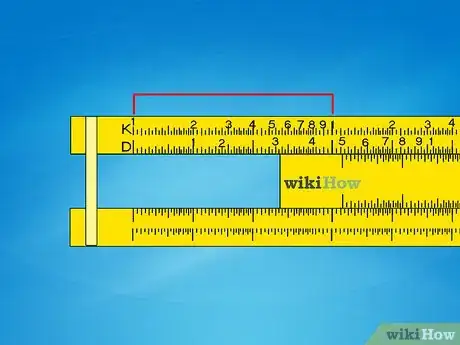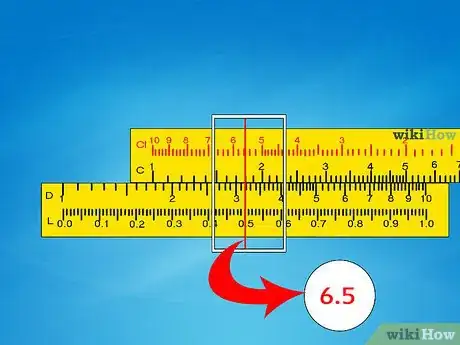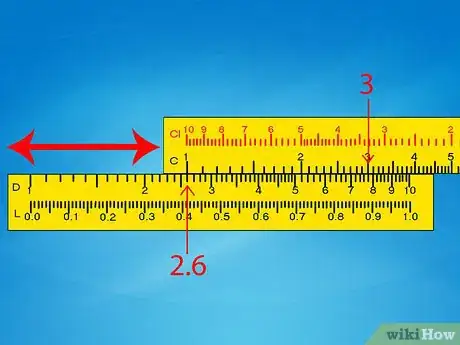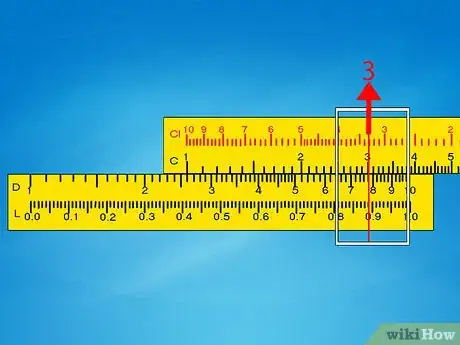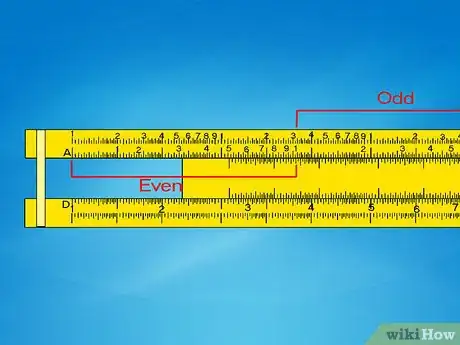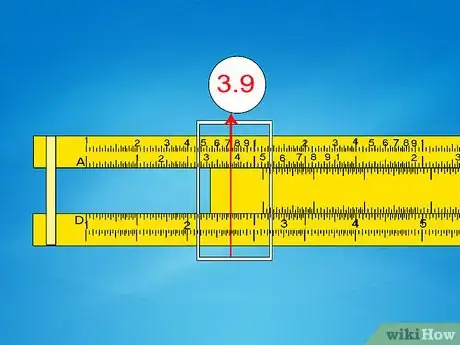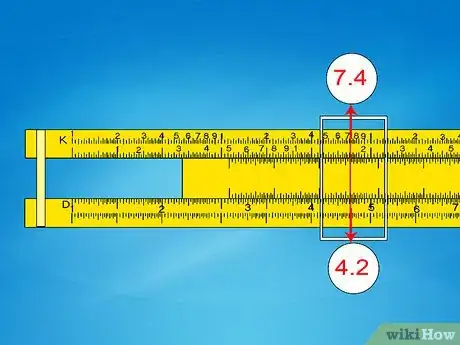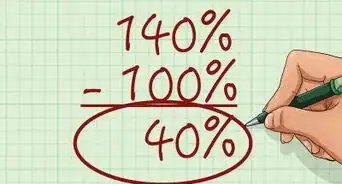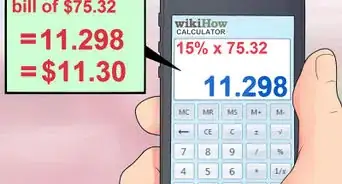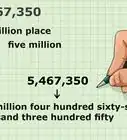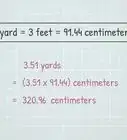wikiHow is a “wiki,” similar to Wikipedia, which means that many of our articles are co-written by multiple authors. To create this article, 11 people, some anonymous, worked to edit and improve it over time.
This article has been viewed 91,187 times.
Learn more...
To someone who doesn't know how to use it, a slide rule looks like a ruler designed by Picasso. There are at least three different scales, and on most of them the numbers aren't even spaced evenly apart. But after you learn about it, you can see why the slide rule was so useful in the centuries before pocket calculators. Line up the right numbers on the scale, and you can multiply any two numbers together, with much less math than you would use with pencil and paper.
Steps
Understanding Slide Rules
-
1Notice the gaps between numbers. Unlike an ordinary ruler, the numbers on a slide rule scale aren't spaced on an even, linear scale. Instead, the numbers are spaced using a special "logarithmic" formula, closer together on one side than the other. This lets you line up the scales to get the answer to multiplication problems, as described below.
-
2Look for scale labels. Each scale on the slide rule should have a letter or symbol identifying it, printed to the left or right. This guide will assume your slide rule uses the most common notation:[1]
- The C and D scales each look like a single stretched out ruler, reading from left to right. These are called "single decade" scales.
- The A and B scales are "double decade" scales. Each one has two smaller stretched rulers stacked end-to-end.
- The K scale is a triple decade scale, or three stretched rulers stacked end-to-end. Not all models have this.
- The C| and D| scales are the same as the C and D scales, but read right to left. These are often printed in red. Not all models have these.
- Note that slide rules vary, so the scales marked "C" and "D" on your slide rule may not be the same as those described here. One some slide rules the scales used for multiplication are marked "A" and "B" and are on the top. Whatever the designating letter, these scales often have the Pi symbol marked at the suitable place and are almost always the two scales opposing each other on the slides, either the upper or lower gap. It is suggested you try a few simple multiplication problems to verify that you are using the correct scale as described in the article. If "2x4" doesn't come to "8", try the scales on the other side of the slide rule instead.
Advertisement -
3Interpret the divisions of the scale. Take a look at the vertical lines of the C or D scale, and get used to reading them:
- The primary numbers on the scale begin with 1 on the extreme left edge, extend up to 9, then end with another 1 on the far right edge. These are usually all labeled.
- The secondary divisions, marked by the second-tallest vertical lines, divide each primary number by 0.1. Don't be confused if these are labeled "1, 2, 3;" remember they actually represent "1.1, 1.2, 1.3" and so on.
- There are usually smaller divisions, typically representing increments of 0.02. Pay close attention, since these may disappear on the high end of the scale, where numbers get closer together.
-
4Don't expect exact answers. You'll often have to make a "best guess" when reading a scale, when the answer doesn't fall exactly on a line. Slide rules are used for quick calculations, not for purposes that require extreme precision.
- For instance, if the answer falls between the 6.51 and 6.52 marks, write down whichever value it's closer to. If you can't tell, write 6.515.
Multiplying Numbers
-
1Write down the numbers you are multiplying. Write down the two numbers you plan to multiply together.
- In Example 1 throughout this section, we'll calculate 260 x 0.3.
- In Example 2, we'll calculate 410 x 9. This ends up being a little more complicated than Example 1, so you might want to follow Example 1 first.
-
2Move the decimal points for each number. The slide rule is only labeled with numbers between 1 and 10. Move the decimal point in each number you are multiplying, so they fall between these values. After the problem is complete, we'll move the decimal point in the answer back to the right place, as described at the end of this section.[2]
- Example 1: to calculate 260 x 0.3 on a slide rule, start with 2.6 x 3 instead.
- Example 2: to calculate 410 x 9, start with 4.1 x 9 instead.
-
3Find the smaller number on the D scale, then slide the C scale onto it. Find the smaller number on the D scale. Slide the C scale so the "1" on the far left (called the left index) is directly in line with that number.[3]
- Example 1: slide the C scale so the left index is in line with the 2.6 on the D scale.
- Example 2: slide the C scale so the left index is in line with the 4.1 on the D scale.
-
4Slide the metal cursor to the second number on the C scale. The cursor is the metal object that slides over the entire slide rule. Line the cursor up with the second number in your multiplication problem, on the C scale. The cursor will point to the answer to your problem on the D scale.[4] If it can't slide that far, go to the next step.
- Example 1: slide the cursor so it points to 3 on the C scale. At this position it should also point to 7.8 on the D scale, or extremely close to it. Skip ahead to the estimation step.
- Example 2: try to slide the cursor so it points to the 9 on the C scale. On most slide rules, this will not be possible, or the cursor will be pointing to empty air off the end of the D scale. See the next step for how to fix this.
-
5Use the right index instead if the cursor won't slide to the answer. If the cursor is blocked by a "bridge" in the center of the slide rule, or if the answer is "off the scale," take a slightly different approach instead.[5] Slide the C scale so the right index, or the 1 on the extreme right end, is located over the larger factor in the multiplication problem. Slide the cursor to the location of the other factor on the C scale, and read the answer on the D scale.
- Example 2: slide the C scale so the 1 on the far right lines up with the 9 on the D scale. Slide the cursor to 4.1 on the C scale. The cursor is pointing to the D scale in between 3.68 and 3.7, so the answer must be about 3.69.
-
6Use estimation to find the correct decimal point. No matter what multiplication you try, your answer will always be read off the D scale, which only displays numbers from one to ten. You'll need to use some estimation and mental math to determine where to put the decimal point in your actual answer.
- Example 1: Our original problem was 260 x 0.3, and the slide rule gave us an answer of 7.8. Round the original problem to convenient numbers and solve it in your head: 250 x 0.5 = 125. This is much closer to 78 than it is to 780 or 7.8, so the answer is 78.
- Example 2: Our original problem was 410 x 9, and we read an answer of 3.69 on the slide rule. Estimate the original problem as 400 x 10 = 4,000. The closest we can get to that by moving the decimal point is 3,690, so that must be the actual answer.
Finding Squares and Cubes
-
1Use the D and A scales to find squares. These two scales are typically fixed in place. Simply slide the metal cursor to a value on the D scale, and the A value will be its square.[6] Just like a multiplication problem, you'll need to determine the position of the decimal point yourself.
- For example, to solve 6.12, slide the cursor to 6.1 on the D scale. The corresponding A value is about 3.75.
- Estimate 6.12 to 6 x 6 = 36. Position the decimal point to get an answer near this value: 37.5.
- Note that the exact answer is 37.21. The slide rule answer is off by less than 1%, easily accurate enough for most real-world circumstances.
-
2Use the D and K scales to find cubes. You've just seen how the A scale, which is a D scale shrunk to 1/2 scale, lets you find the square of numbers. Similarly, the K scale, which is a D scale shrunk to 1/3 scale, lets you find the cubes. Simply slide the cursor to a D value and read the result on the K scale. Use estimation to place the decimal.[7]
- For example, to solve 1303, slide the cursor to 1.3 on the D value. The corresponding K value is 2.2. Since 1003 = 1 x 106, and 2003 = 8 x 106, we know the answer must be somewhere between them. The answer must be 2.2 x 106, or 2,200,000.
Finding Square Roots and Cube Roots
-
1Convert the number to scientific notation before finding a square root. As always, the slide rule only has values from 1 to 10, so you'll need to write the number in scientific notation before you can find its square root.[8]
- Example 3: to solve √(390), write it as √(3.9 x 102).
- Example 4: to solve √(7100), write it as √(7.1 x 103).
-
2Determine which side of the A scale to use. To find the square root of a number, the first step is sliding the cursor to that number on the A scale. However, since the A scale is printed twice, you'll have to decide which one to use first.[9] To do so, follow these rules:
- If the exponent in your scientific notation is even (such as 2 in Example 3), use the left side of the A scale (the "first decade").
- If the exponent in your scientific notation is odd, (such as 3 in Example 4), use the right side of the A scale (the "second decade").
-
3Slide the cursor on the A scale. Ignoring the exponent of ten for now, slide the metal cursor along the A scale to the number you've ended up with.[10]
- Example 3: To find √(3.9 x 102), slide the cursor to 3.9 on the left A scale. (Use the left scale because the exponent is even, as described above.)
- Example 4: To find √(7.1 x 103), slide the cursor to 7.1 on the right A scale. (Use the right scale because the exponent is odd.)
-
4Determine the answer from the D scale. Read the D value where the cursor is pointing. Add "x10n" to this value. To calculate n, take the original power of 10, round down to the nearest even number, and divide by 2.[11]
- Example 3: The corresponding D value at A=3.9 is about 1.975. The original number in scientific notation had 102. 2 is already even, so just divide by 2 to get 1. The final answer is 1.975 x 101 = 19.75.
- Example 4: The corresponding D value at A=7.1 is about 8.45. The original number in scientific notation had 103, so round the 3 down to the nearest even number, 2, then divide by 2 to get 1. The final answer is 8.45 x 101 = 84.5.
-
5Use a similar process on the K scale to find cube roots. The process for finding cube roots is very similar. The most important step is determining which of the three K scales to use. To do this, divide the number of digits in your number by three and find the remainder. If the remainder is 1, use the first scale. If 2, use the second scale. If 3, use the third scale. (Another way to accomplish this is to repeatedly count from the first scale to the third, until you reach the number of digits in your answer.)[12]
- Example 5: To find the cube root of 74,000, first count the number of digits (5), divide by 3 and find the remainder (1 remainder 2). Since the remainder is 2, use the second scale. (Alternatively, count the scales five times: 1–2–3–1–2.)
- Slide the cursor to 7.4 on the second K scale. The corresponding D value is approximately 4.2.
- Since 103 is smaller than 74,000, but 1003 is larger than 74,000, the answer must be in between 10 and 100. Move the decimal point to make 42.
Warnings
- Keep your slide rule away away from heat and damp. Warping and shrinking can make the slide rule inaccurate.[13]⧼thumbs_response⧽
References
- ↑ http://sliderulemuseum.com/SR_Course.htm
- ↑ https://web.mit.edu/2.972/www/reports/slide_rule/slide_rule.html
- ↑ https://web.mit.edu/2.972/www/reports/slide_rule/slide_rule.html
- ↑ https://www.nmt.edu/advancement/docs/sliderulehandout.pdf
- ↑ http://sliderulemuseum.com/SR_Course.htm
- ↑ https://www.nmt.edu/advancement/docs/sliderulehandout.pdf
- ↑ https://www.nmt.edu/advancement/docs/sliderulehandout.pdf
- ↑ https://web.mit.edu/2.972/www/reports/slide_rule/slide_rule.html
- ↑ http://www.sliderules.info/a-to-z/tys/tys03.htm#A%20and%20B%20Scales
- ↑ https://www.physics.wisc.edu/ingersollmuseum/wp-content/uploads/sites/10/2020/04/scientificamerican0506-80-WhenSlideRulesRuled.pdf
- ↑ https://www.physics.wisc.edu/ingersollmuseum/wp-content/uploads/sites/10/2020/04/scientificamerican0506-80-WhenSlideRulesRuled.pdf
- ↑ https://www.physics.wisc.edu/ingersollmuseum/wp-content/uploads/sites/10/2020/04/scientificamerican0506-80-WhenSlideRulesRuled.pdf
- ↑ http://www.sliderules.info/a-to-z/tys/tys03.htm
About This Article
To use a slide rule to multiply 2 numbers together, move the decimal points for each number you are multiplying so they fall between the values of 1 and 10. Next, find the smaller number on the D scale and slide the C scale so the "1" on the far left lines up with the smaller number. Then, line the metal cursor up with the second number on the C scale. The cursor will point to the answer to your problem on the D scale. For tips on using a slide rule to find squares and cubes, read on!
